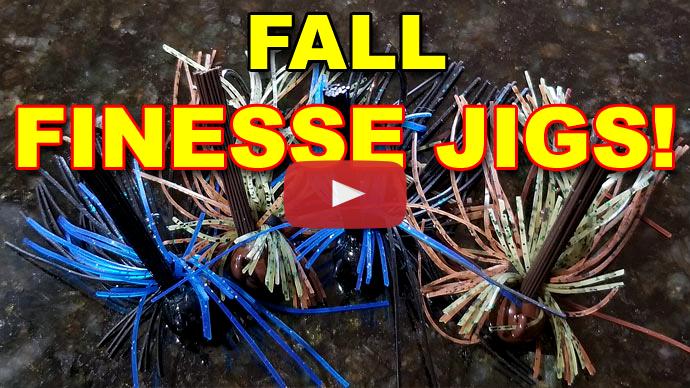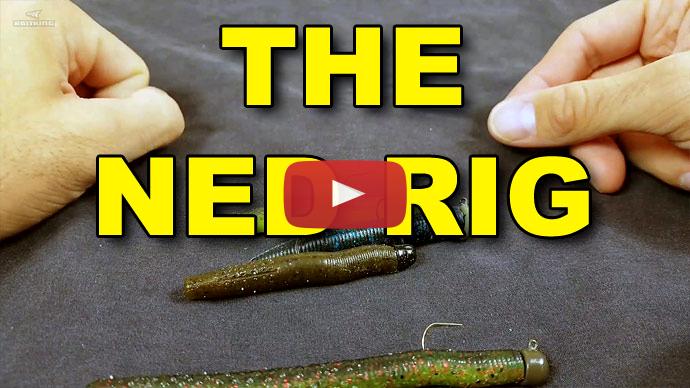Hey, folks. Glenn May here with BassResource.com. Today, I'm going to talk to you about fishing the Hula Grub. Great bait for smallmouth fishing. This is a bread and butter bait. If you're fishing for smallies, this is an awesome bait to use. What's we're going to do is I'm going to show you a little bit about how to rig it, how to use it, and then we're going to take you out on the water and we're going to go fish it.
I’ve just got this rigged on a ball head jig that very straight forward. I'm not fishing this in any cover or anything, just open water, not a whole lot of rocks and stuff so I'm going to be fishing that ball head jig. Football head jig works just as well. It actually works really well if you're fishing a lot of rocks and stuff. It doesn't get hung up as much.
If you want, you can get jig heads with a wire guard on it. That will prevent weeds will get hung up in there if you're fishing a little bit of weeds or a little bit of woody cover. It'll help prevent some of those hang ups. But that's it. Just a ball head jig or a football head, perfect for those situations for fishing this bait.
I'm using an eighth-ounce jig head. That's a good starter. You can go a quarter-ounce, a three-eighth-ounce, any more than that's a little too heavy. A lot of the bites come on the fall, so you want a slow fall, so an eighth-ounce is perfect for that.
I'm using six-pound fluorocarbon line on this. Nice, clear line. It's got good sensitivity on it. I can feel that since we're using this on slack line, you need that sensitivity, so fluorocarbon line is what we're using today. Six-pound test. Because it's a real light-wire hook here, we don't want to get too heavy on that. Don't want to use heavy line. A light line also allows this bait to fall freely. It's not going to inhibit the action of it.
But also we want to make sure that we match it with the right rod. So this rod is a medium/light action rod spinning outfit. That's what we're going to be using today. Don't use anything heavier than that. A medium/heavy action rod is too much. You might end up breaking the line or straightening out the hook during the hooks out of the fight back to the boat. So medium/light action's got plenty of give. It's got good backbone still to fight that fish and set that hook. All right, so that's the gear we're going to be using. Now let's go out and fish it.
All right. So with the Hula Grub, it's very simple to fish, actually. All you're going to do is cast it out there and pay real close attention while the bait is dropping. You want to fall on a completely slack line. So when you're doing that, it's really hard to detect the bite. The only way you're going to know is by watching the line where it enters the water. So you want to see if that line twitches, jumps, pops, moves, if it starts to peel off faster than it was, just anything different that you didn't cause, it's probably a fish.
So first thing you want to do is cast it out there, and that's what I'm going to do. I'm going to cast it out here and watch that line. I'm just going to flip the bail over, bring the rod tip down so I'm ready to set the hook, and watch that line carefully. I’m watching it fall, watching it fall, watching it fall. Okay, and it hit the bottom. And the reason I know it hit the bottom is the line just stopped moving and it went slack.
Okay. Now what we're going to do is we're going to lift that, reel down to it and just lift it up the bottom, and let it fall again on slack line. Only this time, if you watch, I'm going to bring the rod tip down about the same speed as the bait is falling, and I'm going to reel up that slack. I still want that bait to fall straight down, but here, I'm going to maintain contact with it. This is what some people refer to as a semi-slack line. The reason you want to do that is because a lot of times, the bite happens on the fall, or when you lift up on it, sometimes that's when it'll hit.
They'll watch it sit on the bottom, you lift it up, and suddenly they'll just grab it. Come here, good. I want to show your face. Come here. It's a good fish. These smallies sure fight hard. All right, come here. Come here. Oh, good size fish here. All right. That's all the Hula Grub. It's the kind of fish you're going to catch with this bait.
Yeah, moving along the bottom, I just sit and let it sit down there, and when I lift it up, that's when he popped it. Let him go. There we go. All right. Now. So just pay real close attention when you do that stuff because they'll just lift a hint, he never thumped it. I didn't feel a tap tap or anything. You just lifted it up and grabbed it right when I started picking it up off the bottom.
Throw it back out there, and I'll show you one other way to do the retrieve. So that one was you lift it up, let it drop on slack line. Again, I'm watching the bait. Here, though, this time we want to drag it on the bottom. It's like, you want to imitate a bait, you know, a fish that's feeding off the bottom or a crawdad. Like a sculpin or something like that or a crawdad. So all you're going to do is keep the rod tip pointed down, and you're just going to crawl it on the bottom. Just reel it, move it with your rod tip, reel up the slack, keep your rod tip down so you're ready to set the hook, and just move it.
And if you notice, when I set the hook. You know, I didn't set the hook that hard on that fish. You have an exposed hook, it's a light-wire hook, I won't use a six-pound test so you don't have to set it really hard. Not at all. And you'll have that fish. And those are the basic ways to fish it.
Another way I'd like to do this, you know, I'll throw this out there, past the back of the boat, and I'll give it an extra couple 10, 15 feet of line, and I'll just drag it along the bottom using the trolling motor. I'll drag it along maybe, set the trolling motor about 10, 20, drag it along and just cover in deep water. Great way to fish particularly in the winter, or in the summertime when the fish are holding off on drops, ledges, creek channels, when they're fishing, when they're holding off on rock humps. Anything like that during the winter or the summer time, that's what you want to fish and just drag it along the bottom. And a lot of times, the fish will just pick it up right up off the bottom. Great way to fish. All right?
Anyway, those are the different ways to fish this bait. You can see what kind of fish it caught, like the one I just caught. You're going to have a whole heck of a lot of fun with this. For more tips and tricks like that, visit BassResource.com.



